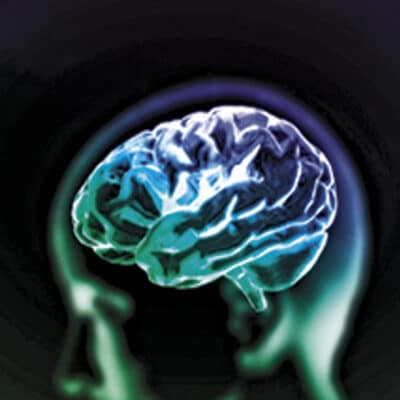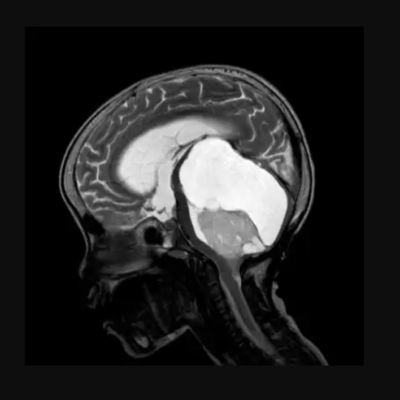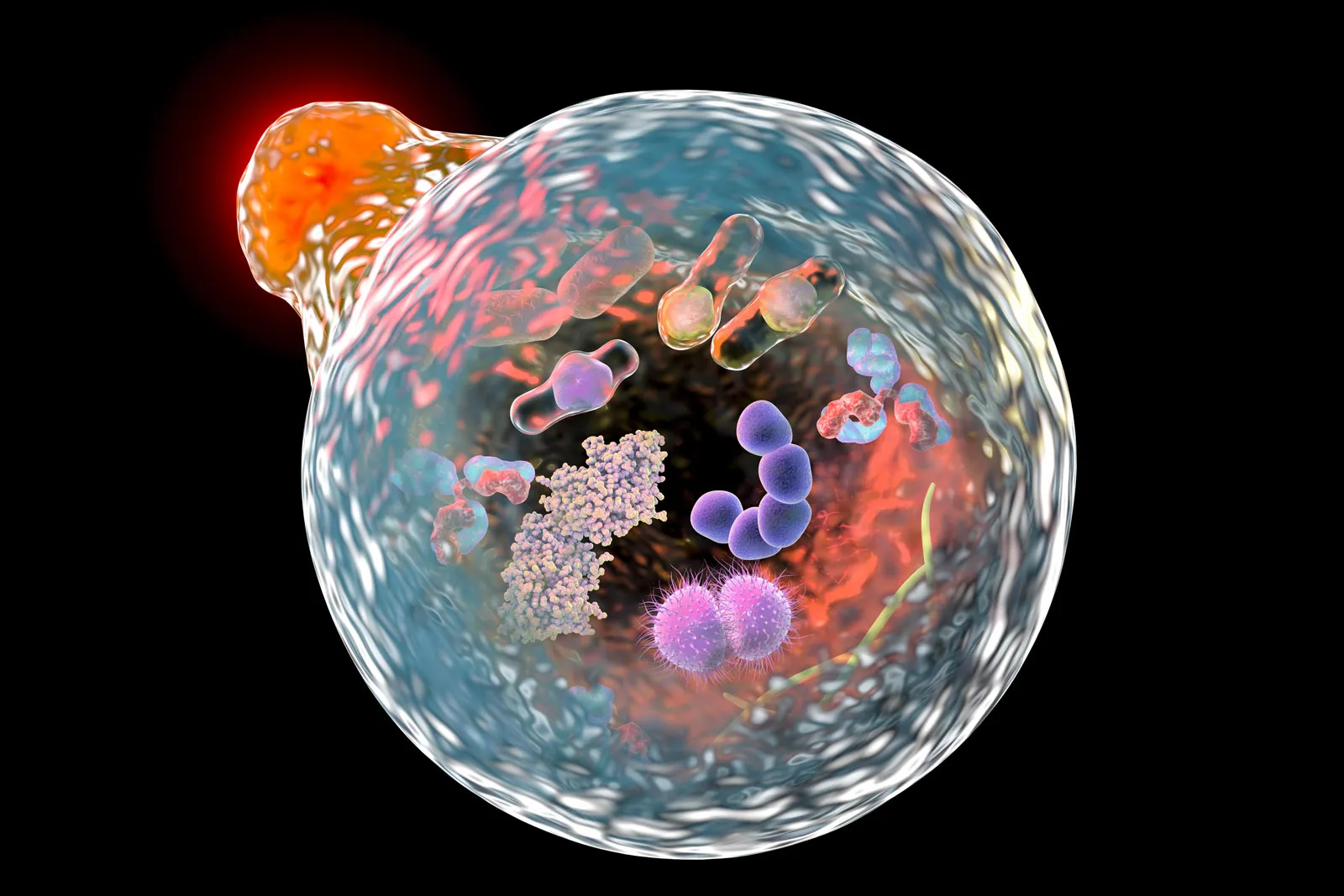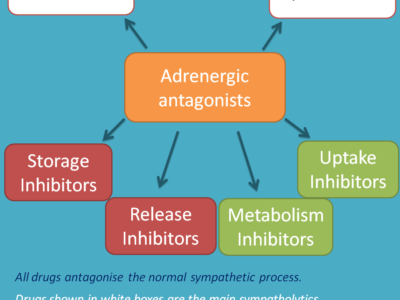Article Topic: Adrenergic Agonists
Author: Ayah Bani Mustafa
Keywords: Adrenergic, Adrenergic Agonists, Adrenergic Receptors, Alpha Receptors, Beta Receptors, Adrenergic Drugs, Adrenaline, Noradrenaline, SABA, LABA
Scientific Editor: Marah Bassam Akhdar
Linguistic Editor: Noor AlOsta.
The word adrenergic is defined as the mimicking of adrenaline/noradrenaline effects upon binding with an adrenergic receptor. Adrenergic receptors are the receptors that the adrenergic drugs get attached to. These receptors are classified into alpha-1, alpha-2, beta-1, beta-2, and beta-3. They are all G-coupled receptors. Moreover, adrenergic drugs are often referred to as sympathomimetics which means mediating a sympathetic nervous system effect-like. There are many types of sympathomimetics. On one hand, adrenergic agonists can be classified according to the type of receptor they bind to and the effect they mediate as a result of this binding as [1]:
- Alpha-1 receptor binding agonist:Causes smooth muscle contraction (Action potential generation), mydriasis of the eye, vasoconstriction thus increasing blood pressure, and urinary retention.
- Alpha-2 receptor binding agonist:Causes mixed smooth muscle effects (according to the type and action of the muscle), and decreases insulin secretion.
- Beta-1 receptor binding agonist:Causes an increase in cardiac chronotropic (heart rate) and inotropic (contractility) effects, increases renin release, and increases blood pressure.
- Beta-2 receptor binding agonist: Causes bronchodilation, increased glycogenolysis, and vasodilation in skeletal muscle.
- Beta-3 receptor binding agonist:Causes increased lipolysis in adipose tissue and relaxation of the smooth muscle of the bladder.
Note: An adrenergic drug can bind to one or more of these receptor sub-types with different selectivity and they bind to more receptors as their concentration increases [1].
On the other hand, adrenergic agonists can be classified according to their mechanism of action as:
Direct acting adrenergic agonists: These are agents that bind directly to the receptor producing the effect of sympathetic nerve end depolarization/ releasing of epinephrine from the medulla of the kidney. These agonists include:
–Epinephrine: It is a synthetic catecholamine as the product of methylation of norepinephrine. It is released from the medulla of the kidney and binds to all sub-types of the adrenergic receptors with different selectivity according to different concentrations. Its effects are :
- Cardiovascular system: Positive inotropic and chronotropic (Beta-1 action) effects, which leads to increased cardiac output, increased renin release from the kidneys (Beta-1 action) which leads to vasoconstriction in skin, mucous membranes, and viscera. It also leads to vasodilation in skeletal muscles and liver (Beta-2 effect).
- Respiratory system: Bronchodilation as an effect of the relaxation of the smooth muscle of bronchiole (Beta-2 effect). It also decreases allergic mediators release; such as histamine.
- Hyperglycemia as a result of increased glycogenolysis in the liver and increased glucagon release (Beta-2 effects), decreased insulin release (Alfa-2 effect).
- Lipolysis as a result of beta receptors in adipose tissue.
Side effects of epinephrine include:
- CNS effects; such as: Anxiety, fear, headache and tremor.
- Cardiac arrhythmias (especially with digoxin).
- Pulmonary edema.
– Norepinephrine: It is the neurotransmitter of nerve ends. With that being said, it affects all types of adrenergic receptors by binding directly to them.On high doses, it predominantly activate alpha-1 receptors, while on low doses, it predominantly activates beta-1 receptors [2]. Its structure is the same as epinephrine except that it lacks one methyl group compared to epinephrine. Its effects are:
- Vasoconstriction: Intense vasoconstriction (Alpha-1 effect) which leads to increased peripheral resistance and increased blood pressure.
- Baroreceptors may be activated which leads to increased activation of the vagus nerve and thus causing bradycardia.
Side effects of norepinephrine include:
- Decreased end-organ perfusion.
- Pulmonary vascular resistance which could be an effect of interest in patients with pulmonary hypertension.
- Decreased hepatic blood flow, which may affect drugs metabolism[3].
–Isoproterenol: It is a synthetic catecholamine that binds directly to beta receptors, non-selectively. Its effects are:
- Elevated heart rate (positive chronotropy), contractility (positive inotropy) and cardiac output(Beta-1 effect).
- Arterioles dilation in skeletal muscle (Beta-2 effect) which results in decreased peripheral resistance.
- Bronchodilation(Bronchial relaxation),relaxation of gastrointestinal and uterine smooth muscles (Beta-2 effect).
- Hepatic glycogenolysis and glucagon release from the pancreas (Beta-2 effect)[4].
Side effects of isoproterenol include: headache, dizziness, stomach upset, fatigue, angina, flushing, dyspnea, nausea, vomiting, tremor and shaking.
–Dopamine: It is a physiological neurotransmitter in the CNS and medulla. It affects all adrenergic receptors by binding directly to them. It is a precursor in norepinephrine synthesis. Its effects are[5]:
- Positive inotropic by beta 1 receptor stimulation
- Positive chronotropic by beta 1 receptor stimulation
Side effects of Dopamine include: Increased urinary flow, adversely affects functions of the kidney, addiction, impulse control disorders, and irregular heartbeats.
–Dobutamine: It is a synthetic catecholamine that works as a beta-1 selective agonist. It increases heart rate and contractility leading to increased cardiac output and increased atrioventricular conduction.
Side effects of dobutamine include: increasing systolic blood pressure , premature ventricular beats, hypokalemia, nausea, headache,shortness of breath (rarely) [6].
–Phenylephrine: It is a synthetic adrenergic agonist that binds directly to alpha-1 receptors leading to :
- Vasoconstriction which increases systolic and diastolic pressure, and reflex bradycardia.
- Nasal decongestion.
- Mydriasis of the eye.
Side effects of phenylephrine include: nausea, vomiting, headache,and nervousness[7].
–Clonidine: It is an alpha-2 agonist which affects presynaptic alpha-2 receptors centrally, resulting in the inhibition of sympathetic outflow to peripheral nerves. It also causes a decrease in circulating epinephrine.Its effects are :
- Decrease cardiovascular nerve activation.
- Decrease arterial blood pressure.
Side effects of clonidine: abdominal pain, headache, hypotension,sedation,and xerostomia[8].
–SABA (Albuterol, terbutaline), LABA (Salmeterol, formoterol): These two groups are beta-2 agonists which differ in their onset of action. SABA is short acting beta-2 agonist, while LABA is a long acting beta-2 agonist.Their effects are:
- Bronchodilation.
- Uterine relaxation (especially terbutaline).
Side effects of SABA and LABA include: tremor, restlessness,anxiety, tachycardia, arrhythmias and other cardiovascular events.
–Mirabegron: It is a beta-3 agonist that relaxes detrusor muscle to increase bladder capacity. It also increases blood pressure.
Side effects of mirabegron include:hypertension, nasopharyngitis, urinary tract infection,headache, abdominal pain,and fatigue[9].
Indirect-acting adrenergic agonist: These increase the concentration of norepinephrine and epinephrine through various mechanisms including: Inhibiting their reuptake, inhibiting the degradation, or increasing the release of epinephrine and norepinephrine. These agonists include:
–Amphetamine: It is structurally similar to catecholamine neurotransmitter. This drug is a central nervous system (CNS) stimulant that results in an increase in the amounts of dopamine, norepinephrine and serotonin (to a lesser extent) in the synaptic cleft through a variety of mechanisms.These mechanisms are: entering the presynaptic axon terminal through diffusion/uptake by the monoamine transporters DAT, NET and SERT. When it is inside the presynaptic terminal, amphetamine increases concentrations of monoamine neurotransmitters in the cytosol by the inhibition of vesicular monoamine transporter 2 (VMAT2) and through the disruption of the electrochemical gradients required for vesicular transporter function. Amphetamine also decreases the metabolism of monoamine neurotransmitters by inhibiting monoamine oxidase (MAO) enzyme. Its effects are[10]:
- Increased blood pressure.
- Heart stimulation.
Side effects of amphetamine include: stunted growth in children, risk of cardiovascular events, insomnia, headache, and dry mouth[10,11,12].
–Cocaine: Cocaine enhances the sympathetic nerve by accumulating epinephrine in synaptic spaces.Its mechanism of action is to block the sodium-chloride (Na+/Cl- )-dependent norepinephrine transporter needed for the cellular uptake of norepinephrine into the adrenergic neuron. The latter leads to the amplification of catecholamine concentration and increases their duration of action. It has an anesthetics effect and it can increase blood pressure.
Side effects of cocaine include: acute myocardial infarction,cerebrovascular accident, euphoria, rupture of the aorta, cardiac arrhythmia, and sudden death[13].
Mixed-action adrenergic agonist (Ephedrine,Pseudoephedrine): they belong to the amphetamine family. They don’t only increase the release of norepinephrine stored in nerve endings(indirect action), but also directly stimulate both α and β receptors (direct action). Their effects are similar to epinephrine but are less potent, with longer duration of action.Their effects are:
- Raise systolic and diastolic blood pressures by vasoconstriction and cardiac stimulation.
- Increase alertness, decrease fatigue, and prevent sleep.
- Improve athletic performance.
Side effects include: episodic hypertension, myocardial infarction, stroke, neurological symptoms, hypolipidemia, and appetite suppression[14].











